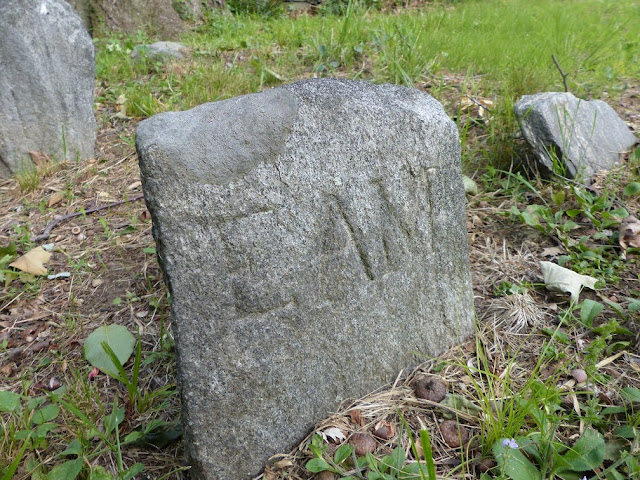Stoney Hill Cemetery is one of the more unusual burying grounds I have visited. Because the site was abandoned for many years, it was absorbed into the forest. Only recently, through a dedicated restoration effort, have the hundreds of burial markers been reclaimed from the wilderness. Most of these markers are rough, unmarked fieldstones. The cemetery belonged to the African-American community known as
Stoney Hill or "The Hills," which began around the time of the American Revolution, when the Quakers of Purchase Meeting manumitted their slaves and gave them 6.5 acres to live on in a rocky, hilly area of what is now the town of Harrison (at its peak, the area of "The Hills" covered
400 acres).

At its height, Stoney Hill had several hundred residents, and between 200 to 400 individuals are thought to be buried in its cemetery. The community also had its own church and schoolhouse. The people worked hard as laborers, servants, coachmen, laundresses, and gardeners to the neighboring wealthy communities. Several dozen men from Stoney Hill enlisted and fought in the Civil War, including the one to whom this gravestone - now sadly broken - was erected (the marble marker is military issue, and you can just make out what I believe to be the letters of his company and regiment).
Most of the people buried in Stoney Hill Cemetery were given simple, unadorned fieldstones. They may have been unable to afford more elaborate markers, but the lack of decoration may also speak to their African heritage and/or Quaker background.

This marker is one of the few commercial gravestones we found. It was very difficult to see the inscription, but by waiting until the sun struck through the canopy just right, I was able to make out the words "Harvey Seymour / April 1, 1805 / March 10, 1904." I found Harvey Seymour in one federal census, in which he is listed as a laborer. The Harrison Public Library posted an article about Seymour in their
digital collections, dating to 1903, which reads:
BORN IN SLAVERY DAYS
Mr. Harvey Seymour (Colored) Will Celebrate His Ninety-Eighth Birthday To-Morrow.
Always Lived in This Vicinity.
Up in "The Hills," a former colored settlement north of St. Mary's Lake, near Silver Lake Park, just across the White Plains village line, to-morrow Mr. Harvey Seymour (colored) will receive all persons who wish to call and pay him respects on his ninety-eighth birthday. The venerable colored man was born in "slavery days in New York State." He was twenty-two years old when the laws of the Empire State made "all men free and equal" before the law. This was in 1827. He was born in King Street, Harrison, east of White Plains, and followed farming all his days. In early life he married, and, following out the old Biblical command of increasing and multiplying, he became the father of eleven children. Two of these still live -- Alonzo Seymour, of this locality, and Mrs. Mary Latham, of Troy, NY. The old man is still in vigorous health. Last week he sawed a cord of wood. His picture which was left yesterday at THE ARGUS office, shows him to be a bright and active man. It is his desire to shake hands with all who will call to greet him. He lives on the old "Alf" Martine place, near Purdy's grocery store. He says he can remember when White Plains had only one house west of Broadway and east of the Bronx River, and that was the old Jacob Purdy house still standing in Spring Street, near Mott Street.
The library also preserves a copy of Harvey Seymour's
marriage record: he married Jane Halstead (a.k.a. Jane Gaul, after her stepfather) on February 25, 1835, in Grace Church. The couple's son, William Henry Seymour, served in the 14th Rhode Island Heavy Artillery Regiment in the Civil War. He survived the war, only to die of dysentery at home in 1866.
Twenty years later, Jane Halstead Seymour filed for a mother's pension from the federal government. Harvey submitted the following
deposition as part of the application:
I raise home vegetables &c. on my patch of ground, which keeps us. I also raise potatoes and cabbage and turnips &c. for winter use. Also some apples. This, along with occasionally a few dollars I earn, and my son's help, is the way in which we have lived for years.
I own this property, which has about one acre of ground. I don't know what it is valued at, but my son pays about $2.40 a year for taxes on it. Neither myself nor my wife have any other property of any kind from which we derive income. We own nothing in the world except this property.
For more information about the Hills, see the book
Freedom Journey: Black Civil War Soldiers and the Hills Community, Westchester County, New York, by Edythe Ann Quinn.
 Canongate Kirkyard, located on the Royal Mile, is the final resting place of Adam Smith and Robert Fergusson, as well as many other less famous people. Above is the gravestone erected to Agnes Mouat, spouse to Robert Rutherfurd (the 18th- and 19th-century Scots were apparently fans of the gender-neutral designation "spouse"). There's a skull, a toppled hourglass, and what is presumably Agnes's spirit rising to heaven in the form of a winged head.
Canongate Kirkyard, located on the Royal Mile, is the final resting place of Adam Smith and Robert Fergusson, as well as many other less famous people. Above is the gravestone erected to Agnes Mouat, spouse to Robert Rutherfurd (the 18th- and 19th-century Scots were apparently fans of the gender-neutral designation "spouse"). There's a skull, a toppled hourglass, and what is presumably Agnes's spirit rising to heaven in the form of a winged head.



































